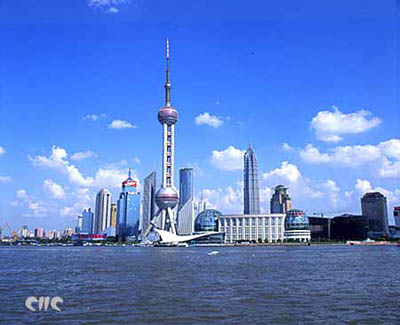Efforts to reduce emissions and clean up the environment in Shanghai are bearing fruit, the director of the local environment bureau said yesterday.
By the end of last month, Shanghai had already achieved 85 percent of the year's emissions targets for sulfur dioxide (SO2) levels and 90 percent of emission targets for chemical oxygen demand (COD), Zhang Quan said.
The city of Shanghai
"With all environmental measures gradually taking effect, it is very likely we will achieve this year's target of reducing 10,000 tons of SO2 and 21,300 tons of COD emissions," he said.
On completion in 2010 of all planned projects to improve the environment, it is likely Shanghai will have reduced its SO2 emission from 513,000 tons in 2005 to 380,000 tons, and COD emission from 304,000 tons to 259,000 tons, Zhang said.
The city's investment in environmentally friendly projects will this year exceed 30 billion yuan ($4 billion), about 3 percent of its gross domestic product, he said.
Desulfurization facilities, used to remove sulfur that constitutes most of the SO2 emissions, have also been introduced in major power stations.
Similarly, 10 wastewater plants have been built this year and 11 old ones have been upgraded to reduce COD emissions.
At present, 73 percent of Shanghai's wastewater is being processed, 2 percentage points higher than last year.
Also, 40 of the city's 49 main and secondary waterways have been cleaned.
Water quality in the two major water sources, Huangpu River and Suzhou Creek, is stable, Zhang said.
"And as of today, Shanghai has recorded 90.5 percent of the days this year as fine or of good air quality," he said.
More is being done to clean the air, Zhang said.
In October, the Shanghai Municipal People's Congress endorsed a new regulation to restrict and monitor exhaust from vehicles.
Zhang said the city's private car plate auction system, which was launched more than a decade ago, has effectively reduced the number of private cars and helped stabilize air quality.
The system regulates the number of private car plates that are issued every month by allotting them to the highest bidder.
Last month, the average price of a car plate was 54,317 yuan ($7,360).
"Considering the huge demand, the government will reduce the number of public car plates, especially those for the Party and political units, next year and give the quota to private car owners," Zhang said.
Responding to recent questions, Zhang said the environmental assessment of the planned maglev rail extension, which is expected to connect the city's two airports and to Hangzhou in Zhejiang Province, found that its magnetic radiation is within a distance of 5 m.
"We will continue efforts to educate the public on the system and dispel worries over its effects," Zhang said.
He admitted that the new rail system - reportedly able to run at speeds of up to 450 kph and expected to be completed by 2010 - will be noisy at such high speeds.
"The government is still studying the best way to minimize the impact on people living near the new lines."
(China Daily December 13, 2007)






